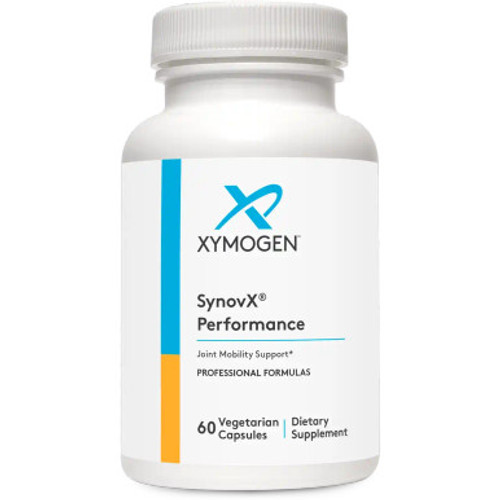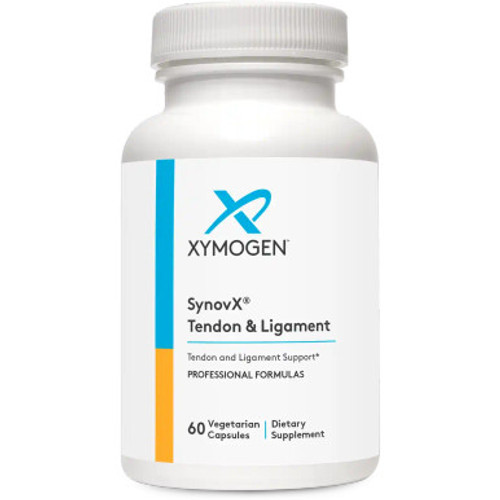SynovX Recovery 120 C by Xymogen
SynovX Recovery 120 C is a bone joint health supplement designed by Xymogen, a brand known for transparency and science-backed formulas.* It utilizes clinically studied glucosamine sulfate and chondroitin sulfate, harnessing their synergistic benefits for optimal joint health and function.*
Who Should Consider SynovX Recovery 120 C by Xymogen?
SynovX Recovery 120 C may support your health if you:
- experience frequent bone joint discomfort*
- engage in regular physical activity*
- experience joint health decline due to aging*
SynovX Recovery 120 C—Effects
SynovX Recovery 120 C by Xymogen may have the following effects:
- supporting bone joint function*
- supporting proteoglycan synthesis for healthy connective tissue*
- helping protect your cartilage cells*
- enhancing post-exercise muscle recovery*
Supplements support your health but do not replace a balanced diet. Always check with your healthcare practitioner if you have doubts about a new supplement. Book a FREE supplement consultation to learn more about SynovX Recovery 120 C by Xymogen.
Recommendation:
Xymogen suggests taking two capsules twice daily, or as directed by your healthcare professional.
Serving Size: 2 Capsules
Servings Per Container: 60
Amount Per Serving:
Glucosamine Sulfate (as glucosamine sulfate sodium chloride) 750 mg
Chondroitin Sulfate (as chondroitin sulfate sodium)S1 600 mg
Methylsulfonylmethane (MSM) 475 mg
Other Ingredients: Capsule (hypromellose and water), ascorbyl palmitate, medium-chain triglyceride oil, and silica.
Contains: Crustacean shellfish (shrimp and crab).
Does Not Contain: Wheat, gluten, corn, yeast, soy, dairy products, fish, peanuts, tree nuts, egg, ingredients derived from genetically modified organisms (GMOs), artificial colors, artificial sweeteners, and artificial preservatives.
Caution: Consult your healthcare professional prior to use. Individuals taking warfarin or other medication should discuss potential interactions with their healthcare professional. Do not use if tamper seal is damaged.
Storage: Keep closed in a cool, dry place out of reach of children. Trademarks:
S1. CSBIOACTIVE™ is a trademark licensed by Bioibérica, S.A.U.
Click here to view New Data Sheet
LEGAL NOTICE: Xymogen's Exclusive Professional Formulas are available through select licensed health care professionals. The Internet Sale and Discounting of XYMOGEN formulas are strictly prohibited.
References:
- Kahan, A., Uebelhart, D., De Vathaire, F., et al. (2009). Long-term effects of chondroitins 4 and 6 sulfate on knee osteoarthritis: The study on osteoarthritis progression prevention, a two-year, randomized, double-blind, placebo-controlled trial. Arthritis & Rheumatism, 60(2), 524–533. https://doi.org/10.1002/art.24320
- Möller, I., Pérez, M., Monfort, J., et al. (2010). Effectiveness of chondroitin sulphate in patients with concomitant knee osteoarthritis and psoriasis: A randomized, double-blind, placebo-controlled study. Osteoarthritis and Cartilage, 18(Suppl 1), S32–S40. https://doi.org/10.1016/j.joca.2010.02.018
- Wildi, L. M., Raynauld, J. P., Martel-Pelletier, J., et al. (2011). Chondroitin sulphate reduces both cartilage volume loss and bone marrow lesions in knee osteoarthritis patients starting as early as 6 months after initiation of therapy: A randomized, double-blind, placebo-controlled pilot study using MRI. Annals of the Rheumatic Diseases, 70(6), 982–989. https://doi.org/10.1136/ard.2010.139386
- Hochberg, M. C., & Clegg, D. O. (2008). Potential effects of chondroitin sulfate on joint swelling: A GAIT report. Osteoarthritis and Cartilage, 16(Suppl 3), S22–S24. https://doi.org/10.1016/j.joca.2008.06.014
- Adebowale, A., Du, J., Liang, Z., et al. (2002). The bioavailability and pharmacokinetics of glucosamine hydrochloride and low molecular weight chondroitin sulfate after single and multiple doses to beagle dogs. Biopharmaceutics & Drug Disposition, 23(6), 217–225. https://doi.org/10.1002/bdd.320
- Tat, S. K., Pelletier, J. P., Mineau, F., et al. (2010). Variable effects of 3 different chondroitin sulfate compounds on human osteoarthritic cartilage/chondrocytes: Relevance of purity and production process. The Journal of Rheumatology, 37(3), 656–664. https://doi.org/10.3899/jrheum.090556
- Barnhill, J. G., Fye, C. L., Williams, W., et al. (2006). Chondroitin product selection for the glucosamine/chondroitin arthritis intervention trial. Journal of the American Pharmacists Association, 46(1), 14–24. https://doi.org/10.1331/154434506775268822
- Glucosamine. (n.d.). Retrieved February 4, 2014, from http://www.naturalstandard.com/databases/herbssupplements/glucosamine.asp
- Kelly, G. S. (1998). The role of glucosamine sulfate and chondroitin sulfates in the treatment of degenerative joint disease. Alternative Medicine Review, 3(1), 27–39.
- Igarashi, M., Kaga, I., Takamori, Y., et al. (2011). Effects of glucosamine derivatives and uronic acids on the production of glycosaminoglycans by human synovial cells and chondrocytes. International Journal of Molecular Medicine, 27(6), 821–827. https://doi.org/10.3892/ijmm.2011.666
- Kapoor, M., Mineau, F., Fahmi, H., et al. (2012). Glucosamine sulfate reduces prostaglandin E2 production in osteoarthritic chondrocytes through inhibition of microsomal PGE synthase-1. The Journal of Rheumatology, 39(3), 635–644. https://doi.org/10.3899/jrheum.110815
- Largo, R., Alvarez-Soria, M. A., Díez-Ortego, I., et al. (2003). Glucosamine inhibits IL-1beta-induced NFkappaB activation in human osteoarthritic chondrocytes. Osteoarthritis and Cartilage, 11(4), 290–298. https://doi.org/10.1016/S1063-4584(02)00261-5
- Selvan, T., Rajiah, K., Nainar, M. S., et al. (2012). A clinical study on glucosamine sulfate versus combination of glucosamine sulfate and NSAIDs in mild to moderate knee osteoarthritis. The Scientific World Journal, 2012, 902676. https://doi.org/10.1100/2012/902676
- Tat, S. K., Pelletier, J. P., Vergés, J., et al. (2007). Chondroitin and glucosamine sulfate in combination decrease the pro-resorptive properties of human osteoarthritis subchondral bone osteoblasts: A basic science study. Arthritis Research & Therapy, 9(6), R117. https://doi.org/10.1186/ar2312
- Lippiello, L., Woodward, J., Karpman, R., et al. (2000). In vivo chondroprotection and metabolic synergy of glucosamine and chondroitin sulfate. Clinical Orthopaedics and Related Research, 381, 229–240. https://doi.org/10.1097/00003086-200012000-00030
- Clegg, D. O., Reda, D. J., Harris, C. L., et al. (2006). Glucosamine, chondroitin sulfate, and the two in combination for painful knee osteoarthritis. New England Journal of Medicine, 354(8), 795–808. https://doi.org/10.1056/NEJMoa052771
- Fransen, M., Agaliotis, M., Nairn, L., et al. (2014). Glucosamine and chondroitin for knee osteoarthritis: A double-blind randomized placebo-controlled clinical trial evaluating single and combination regimens. Annals of the Rheumatic Diseases. Advance online publication. https://doi.org/10.1136/annrheumdis-2013-204808
- Methylsulfonylmethane (MSM). (2003). Monograph. Alternative Medicine Review, 8(4), 438–441.
- Brien, S., Prescott, P., & Lewith, G. (2011). Meta-analysis of the related nutritional supplements dimethyl sulfoxide and methylsulfonylmethane in the treatment of osteoarthritis of the knee. Evidence-Based Complementary and Alternative Medicine, 2011, 528403. https://doi.org/10.1093/ecam/nen023
- Usha, P. R., & Naidu, M. U. (2004). Randomized, double-blind, parallel, placebo-controlled study of oral glucosamine, methylsulfonylmethane and their combination in osteoarthritis. Clinical Drug Investigation, 24(6), 353–363. https://doi.org/10.2165/00044011-200424060-00002
- Kalman, D. S., Feldman, S., Scheinberg, A. R., et al. (2012). Influence of methylsulfonylmethane on markers of exercise recovery and performance in healthy men: A pilot study. Journal of the International Society of Sports Nutrition, 9(1), 46. https://doi.org/10.1186/1550-2783-9-46
- Barmaki, S., Bohlooli, S., Khoshkhahesh, F., et al. (2012). Effect of methylsulfonylmethane supplementation on exercise-induced muscle damage and total antioxidant capacity. Journal of Sports Medicine and Physical Fitness, 52(2), 170–174.







